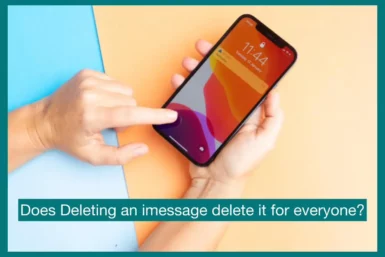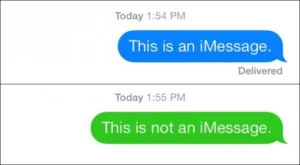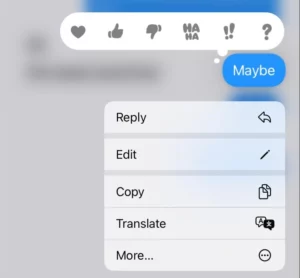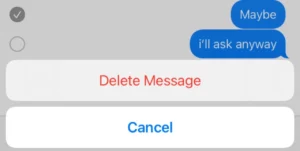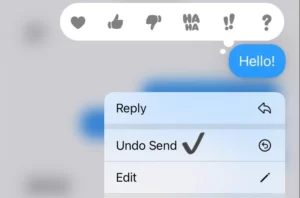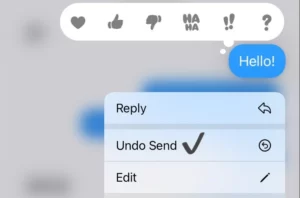Ever wondered what happens after you hit ‘delete’ on an iMessage? Does it vanish from the recipient’s view as well, or does it linger on their device?
Our detailed guide demystifies this query, offering clear insights into how iMessage deletions work.
How iMessage Works?
As an alternative to SMS and MMS, Apple’s proprietary instant messaging service, iMessage, is available. It uses internet access to let users communicate with people who use Apple products by sending them text, images, videos, and even voice recordings.
Unlike conventional text messages, iMessages are end-to-end encrypted. This means the content of your message can only be seen by you and the intended recipient(s).
iMessage is integrated into the Messages app on Apple devices, which automatically switches to using iMessage when it detects that you’re sending a message to another Apple device.
The service also includes several features that are typical of most instant messaging platforms. These include delivery and read receipts, typing indicators, group messaging, and the ability to send a wide range of digital touch messages and Animoji.
Messages are synced across devices through iCloud, making your conversations accessible wherever you log into your Apple account.
Difference Between Deleting and Unsend iMessage
Understanding the functionalities of communication platforms is key to their effective utilization. On Apple’s iMessage platform, two significant actions are “Deleting” and “Unsending.” Although they might seem similar, they possess distinct implications.
Deleting an iMessage
Deleting an iMessage simply removes the message from your device. The process involves highlighting the message, selecting “More,” and then “Delete.”
The key point to remember here is that this action only affects your view. The message remains on the recipient’s device, and they can still read it, regardless of your deletion.
Unsending an iMessage
The “Undo send” feature allows you to retract a message after sending it. By choosing to unsend a message, the text disappears from your screen and the recipient’s device.
This function comes in handy when a message is sent mistakenly, ensuring it doesn’t stay on the other end.
Primary Differences
The fundamental difference between deleting and unsending an iMessage lies in the effect on the recipient’s device.
While deletion is a personal action that only alters the sender’s chat history, unsending has a broader impact as it removes the message from both parties’ devices. Understanding these differences is crucial for effective communication on iMessage.
Does Deleting an iMessage Delete It for Everyone?
Understanding iMessage’s operation is essential to make full use of this well-liked texting service from Apple. One often-asked question is about message deletion and how it affects both individual and group chat situations.
1. Single Chat Deletion
Deleting an iMessage in a single chat conversation will only remove the message from your device. This action doesn’t affect the recipient’s view; they can still see the message on their device.
Therefore, deletion is a unilateral action that primarily serves to manage your own chat history rather than control the availability of the message to the recipient.
2. Group Chat Deletion
Like a single chat, deleting an iMessage from a group chat also only removes the message from your device. Other group chat members will still be able to see the message. This means your action doesn’t impact the chat history of other group participants.
Overall, it’s crucial to understand that deleting an iMessage does not delete it for everyone, whether in a single chat or group chat.
The deleted message will remain visible to others, as the deletion only affects your device. Therefore, always be mindful of what you send, as it can’t be universally unsent or removed from others’ devices through deletion.
3. Unsend an iMessage on iOS 15 and Below
On iOS 15 and prior, unsending an iMessage from both ends is not officially supported. As a result, asking the recipient to manually remove the communication is the only way to ‘delete it on both sides.
Keep in mind that this affects both one-on-one and group interactions.
4. Unsending an iMessage on iOS 16 and Above
Apple has included an ‘Unsend’ feature for iMessage with the release of iOS 16. Follow these steps to use this feature:
- Open the iMessage app and go to the chat where the message you wish to delete is located.
- Until options start to appear, press and hold the message.
- Click “Undo Send.” You will be informed by a confirmation popup that the message will be deleted from all devices, including those of the receivers.
- Verify your actions. The communication will be deleted from both the recipient’s and your devices.
Both solo and group chats can use this new feature. Remember that the ‘Unsend’ option only functions if the recipient and sender are both running iOS 16 or later.
Also, similar to other platforms that offer this feature, there can be a time limit on how long you can undo a message’s sending.
Handling Sensitive Information
While the ‘Unsend’ feature is a significant improvement, it’s always essential to double-check the content of your messages before sending them.
Especially when handling sensitive information, remember that not all recipients may have the updated iOS version, making the unsend feature ineffective.
Conclusion
Understanding the features and limitations of Apple’s iMessage platform is crucial for effective communication. The ability to delete or unsend messages varies depending on the iOS version and impacts only the sender’s device for versions iOS 15 and below.
With iOS 16, the ‘Unsend’ feature provides a way to delete messages on both ends, yet it’s applicable only when all participants use iOS 16 or later.
Despite these advancements, it’s pivotal to exercise caution when sending messages, particularly those containing sensitive information, as the ability to fully retract them is not always guaranteed.

